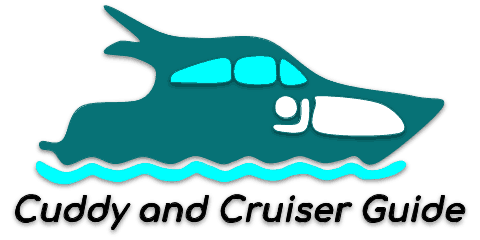Congratulations on becoming a boat owner! You’ve taken the first step towards countless adventures on the open water. But as you venture out, you might find yourself feeling a bit overwhelmed or confused by the process of trimming your boat to plane.
You’re not alone – many new boat owners face the same challenges.
Fortunately, you’re in the right place to learn about getting your boat on plane efficiently and confidently.
In this article, we’ll provide you with the essential knowledge, helpful tips, and step-by-step instructions to guide you through the process. Before you know it, you’ll be trimming your boat like a pro and enjoying smooth, fuel-efficient rides on the water.

Definitions You Need to Know
Before we get started, there are some nautical terms that will be used and it’s best that you learn what these are to have everything make sense. Don’t worry, I’m tossing in five detailed diagrams later that show you exactly what is happening during each step, but learning these terms and concepts is still a good idea to truly grasp what is going on as you attempt to trim a boat to get on plane.
- Trim (up/out, down/in): Trim refers to the angle of the boat’s engine or outdrive in relation to the transom. Adjusting the trim changes the boat’s running angle in the water. When you trim “up” or “out,” you raise the lower unit of the engine or outdrive, causing the bow to rise. Trimming “down” or “in” lowers the lower unit, causing the bow to lower. Proper trim improves performance, fuel efficiency, and ride comfort.
- Transom: The transom is the flat, vertical surface at the stern (rear) of the boat. It provides structural support and is where the engine or outdrive is typically mounted.
- Throttle: The throttle is the control used to adjust the speed of the boat’s engine. By increasing or decreasing the throttle, you control the flow of fuel and air to the engine, which changes the engine’s RPM and, in turn, the boat’s speed.
- Plane: When a boat is on plane, it is moving fast enough that the hull rises out of the water, reducing resistance and allowing the boat to glide smoothly and efficiently. This is the desired state for most powerboats when cruising.
- Wake: The wake is the trail of disturbed water left behind a moving boat. It consists of waves created by the boat’s hull pushing through the water and the turbulence created by the boat’s propeller.
- Porpoising: Porpoising is a term used to describe a boat’s bow repeatedly bouncing up and down, causing an uncomfortable and inefficient ride. This can be caused by an improper trim setting or an unbalanced load on the boat.
- Drag: Drag is the resistance a boat encounters as it moves through the water. Reducing drag improves a boat’s performance and fuel efficiency. Adjusting the trim, balancing the load, and maintaining a clean hull can all help to minimize drag.

Step By Step Process To Get a Boat on Plane
Alright, now for the meat and potatoes of the article. In these steps you’ll be provided with a description of what is happening and I’ll attach a cross-sectional diagram so that you can clearly see what’s happening under water.
Let’s get into it!
Step 1. With Engine in Neutral, Trim In (Down)
With the engine in neutral, lower the propeller down by pressing the lower button on the side of the throttle. Do this until it can’t lower any further. That’s it, ready for the next step?

Step 2: Throttle up to Cruising Speed
Using the throttle, push it forward until you reach your desired cruising speed. The wake (water spray on the sides of the boat) will be near the front of the boat as the engine is pushing the entire hull of the boat through the water, which creates friction and resistance (drag) and causes the boat engine to work very hard and inefficiently with fuel.

Step 3: Trim Up (Out)
Now that you’re at your desired cruising speed, slowly press the top button on the side of your throttle. The engine will start to drive downward in the water which will create a leverage point and the bow (front of the boat) will begin to rise up.
The wake will improve (move backward) but will not be ideal yet. You will notice an increase in speed as the drag is reduced because less of the hull is being forced through the water and it is getting closer to riding on the surface of the water.
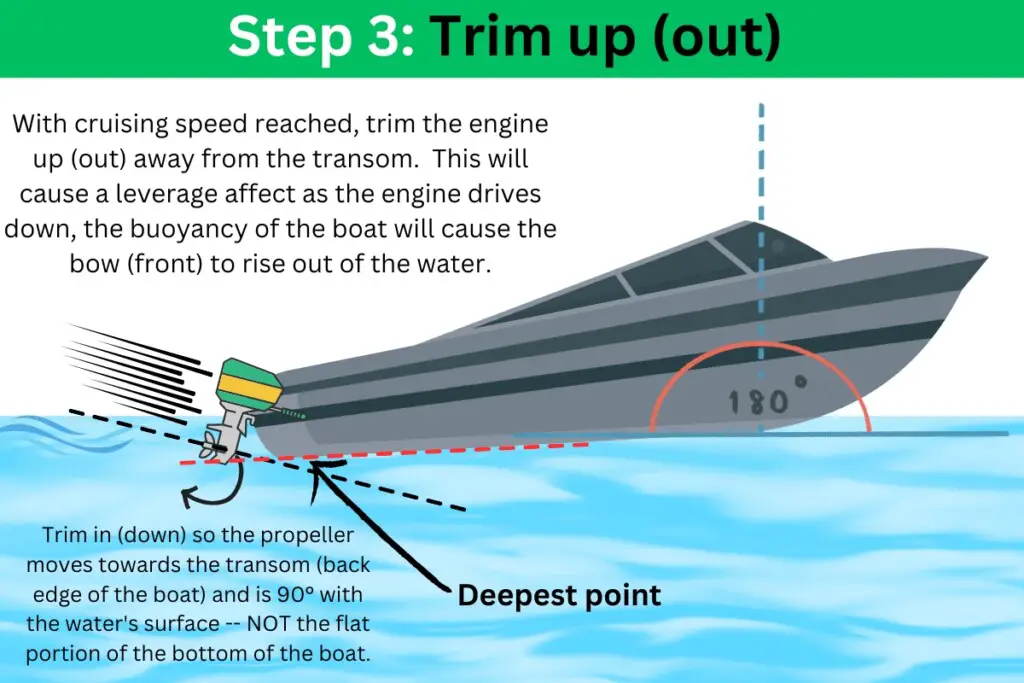
Step 4: Porpoising (Loss of Speed and Increase of Engine RPMs)
In this step, we’re now hitting the opposite of what was happening in step 2. In step 2, we were pushing the entire hull through the water. In this step, most of the hull is out of the water and the engine (because the entire boat is rising up and out of the water) is in too shallow of water and is now trying to work harder to achieve the same speed.
Despite the engine trying as hard as it can, you’ll notice a decrease in speed, an increase in engine RPMs, and the bow (front end of the boat) will rise up and slap back down on the surface of the water in a rhythmic fashion and give you a very bumpy and uncomfortable ride if you continue.
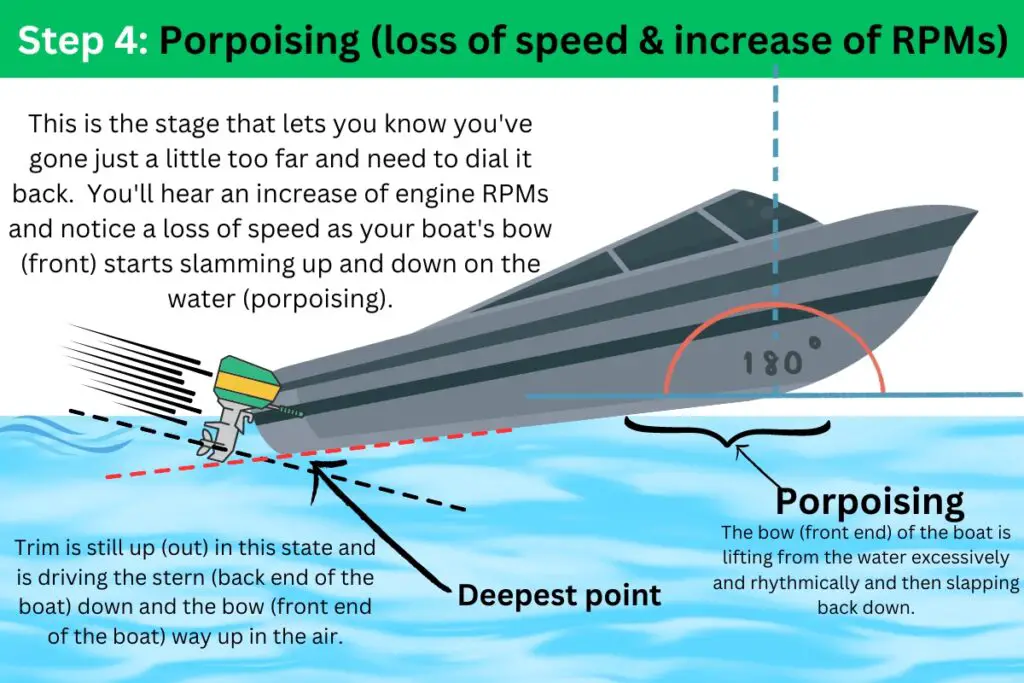
Step 5: Trim Down and Get on Plane
While your boat is porpoising, tap the down button on your throttle to trim down in small increments. You’re looking to sense the moment when the porpoising stops and your engine RPMs drop and stabilize.
At this point, you have now successfully reached the optimal state of efficiency with your boat and are “on plane”. The hull of your boat is now skimming and cutting the surface of the water instead of being pushed through it. Drag is at its lowest, and the wake will now be at the back of the boat.
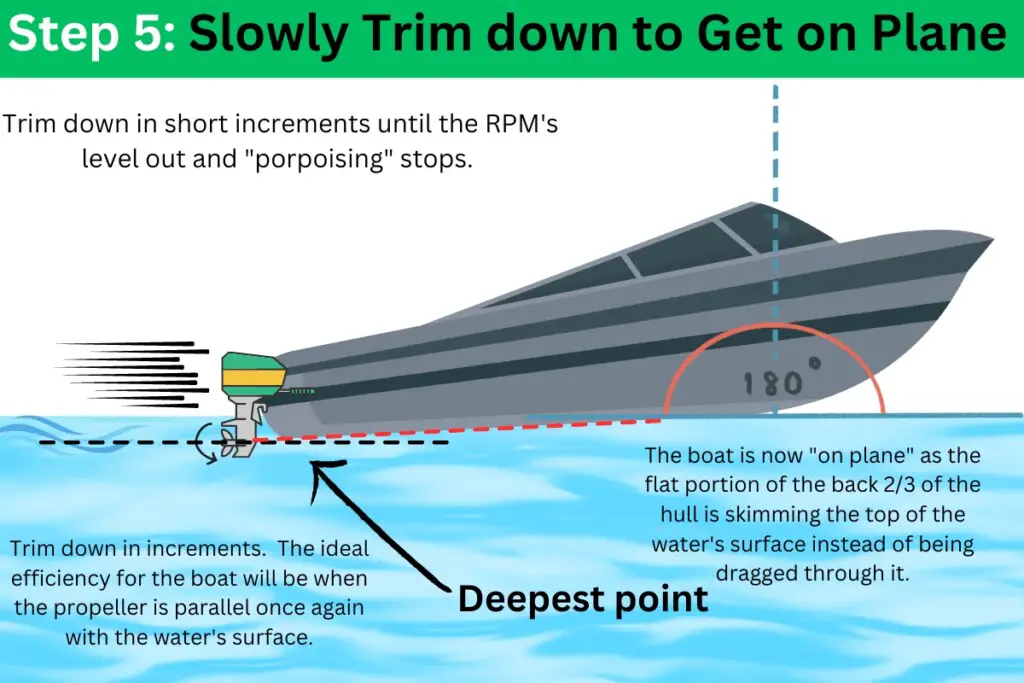
Do’s and Don’ts for Trimming a Boat to Plane
Do:
- Always start with the engine trimmed down before accelerating.
- Gradually increase throttle to reach your desired cruising speed.
- Trim up slowly, paying close attention to the boat’s behavior.
- Adjust trim incrementally to achieve the optimal running angle.
Don’t:
- Over-trim, as this can cause porpoising and an uncomfortable ride.
- Force the throttle abruptly, as this can strain the engine.
- Be afraid to make adjustments as needed; every boat and situation is different.
- Ignore safety precautions, like wearing a life jacket and keeping a proper lookout.
Benefits of Cruising on Plane
Cruising on plane offers several key benefits for boat owners, most notably improved fuel efficiency. As a boat reaches plane, its hull rises out of the water, reducing drag and allowing the vessel to glide more smoothly and efficiently. This reduction in drag leads to increased speed and performance, enabling the boat to cover greater distances in less time.
Additionally, planing contributes to a more comfortable and enjoyable ride, as the boat’s hull skims the surface of the water, providing easier steering and maneuverability. Ultimately, achieving plane reduces stress on the engine and the overall boat system, extending the life of your vessel.
- Improved fuel efficiency due to reduced drag.
- Increased speed and performance.
- Smoother and more comfortable ride.
- Easier steering and maneuverability.
- Less stress on the engine and overall boat system.
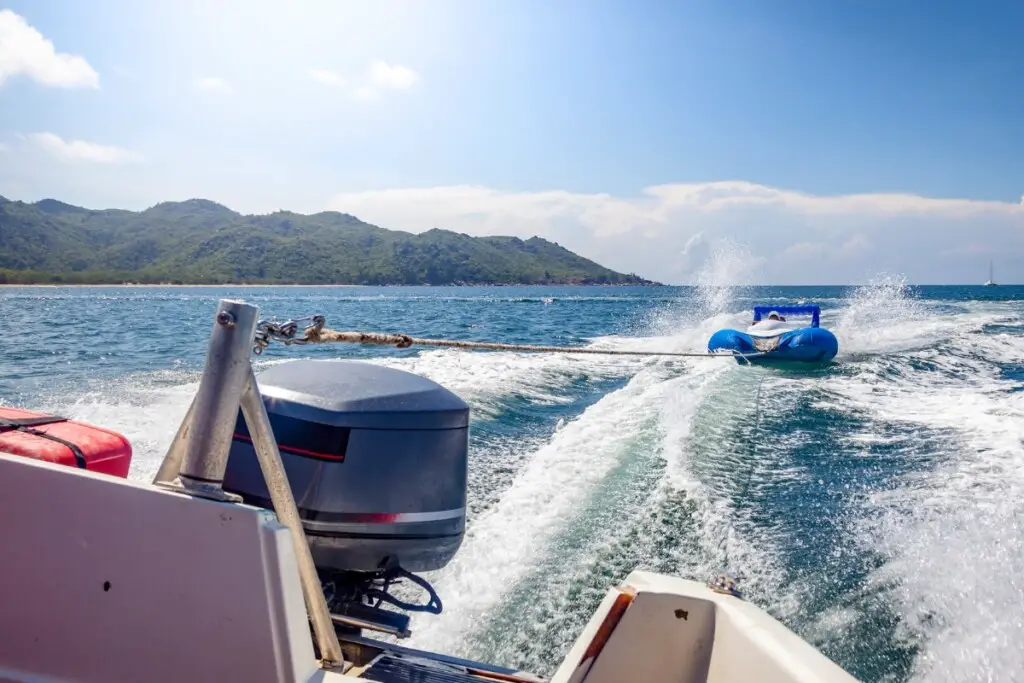
Pro Tips
- Practice trimming your boat in calm water and light wind conditions to get a feel for how it responds.
- Every boat is different, so take the time to understand your specific boat’s characteristics.
- Pay attention to your surroundings and adjust the trim as needed for changes in water conditions, wind, and load distribution.
- Remember that practice makes perfect – the more you trim your boat, the more intuitive it will become.
Weight Distribution when Trimming a Boat to Plane
Weight distribution plays a crucial role in achieving and maintaining a proper plane. To ensure a smooth ride, it’s important to balance the weight on your boat evenly. This includes passengers, gear, and any other items onboard.
Distribute weight as evenly as possible between the bow and stern, as well as port and starboard sides. Proper weight distribution helps your boat achieve plane more easily and maintains a consistent running angle, ensuring a smoother ride and reducing the chances of porpoising or instability during your journey.
Water Conditions (Waves) and Planing a Boat
Riding on plane is an exhilarating experience, but even experienced boaters can find dealing with waves a bit challenging. When your boat is cruising on plane, it’s important to know how to handle various wave conditions to ensure a safe and enjoyable journey.

Assess the Wave Conditions
Before heading out, take the time to assess the wave conditions in the area. Be mindful of the size, frequency, and direction of the waves, as well as any changes in the weather that might impact the conditions. Knowing what to expect will help you prepare and make informed decisions on how to handle waves when your boat is on plane.
Approach Waves at the Right Angle
When encountering waves, the angle at which you approach them can make a significant difference in your boat’s stability and comfort. Ideally, you should approach waves at a 45-degree angle. This allows your boat to cut through the waves more efficiently, reducing the impact on the hull and providing a smoother ride.
Adjust Your Speed
Adjusting your speed is crucial when dealing with waves. If the waves are large or closely spaced, slow down to avoid slamming the hull and causing discomfort or damage to your boat. On the other hand, if the waves are small and spaced further apart, maintaining a consistent speed will help you navigate through them more smoothly.
Trim Your Boat Appropriately
Properly trimming your boat can help you handle waves more effectively. If you’re encountering large or steep waves, you may need to trim your boat down slightly to keep the bow from rising too high and potentially causing instability. Conversely, if you’re navigating through choppy, closely spaced waves, trimming up slightly can help your boat ride over the waves more smoothly.
Distribute Weight Evenly
As mentioned earlier, proper weight distribution is essential for achieving and maintaining a proper plane. It’s equally important when dealing with waves, as an unbalanced boat can become unstable and difficult to control. Make sure passengers and gear are evenly distributed to maintain stability and control in varying wave conditions.
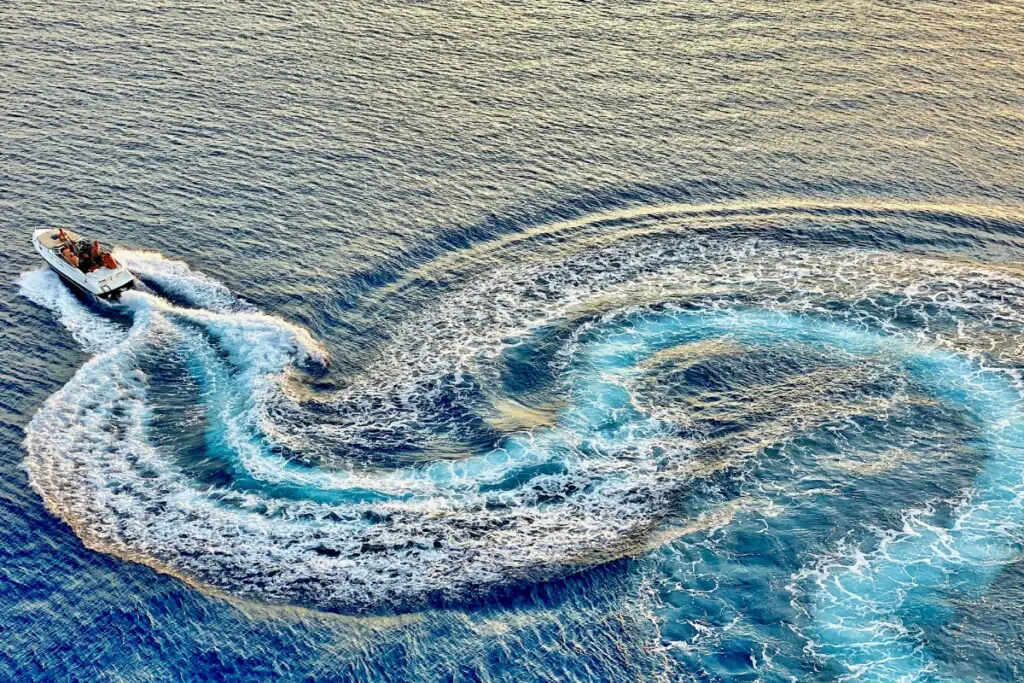
Important Takeaways
Mastering the art of trimming your boat to plane is an essential skill for any boat owner. It’s crucial to familiarize yourself with key nautical terms and follow a step-by-step process to achieve the optimal running angle.
By doing so, you’ll enjoy the benefits of cruising on plane, including improved fuel efficiency, increased speed and performance, and a smoother ride. Keep in mind the importance of weight distribution when trimming your boat, as well as how to handle waves effectively to ensure a safe and enjoyable journey.
Remember, practice makes perfect – the more you trim your boat, the more intuitive it will become. As you venture out onto the open water, use the knowledge, tips, and instructions provided in this article to confidently trim your boat like a pro and make the most of your boating adventures.
